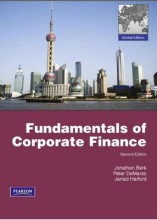Summary: Principles Of Economics | 9780077132736 | Moore McDowell
- This + 400k other summaries
- A unique study and practice tool
- Never study anything twice again
- Get the grades you hope for
- 100% sure, 100% understanding
Read the summary and the most important questions on Principles of economics | 9780077132736 | Moore McDowell ... [et al.].
-
1 Thinking Like an Economist
This is a preview. There are 1 more flashcards available for chapter 1
Show more cards here -
1.1 Studying Choice in a World of Scarcity
This is a preview. There are 3 more flashcards available for chapter 1.1
Show more cards here -
Scarcity Principle (No-free-lunch principle)
... although we have boundless needs and wants, the resources available to us are limited, so having more of one good thing usually means having less of another; hence the cliché "There's ain't no such thing as a free lunch".
-
2 Markets, Specialisation and Economic Efficiency
-
2.1.1 The principle of comparative advantage
-
One person has an absolute advantage over another if:
An hour spent in performing a task earns more than the other person can earn in an hour at the task. -
One person has an comparative advantage over another in a task if:
His or her opportunity cost of performing a task is lower han the other person's opportunity cost. -
The principle of comparative advantage states:
Everyone does best when each person (or each country) concentrates on the activities for which his or her opportunity cost is lowest.
-> the gains made possible from specialization based on comparative advantage constitute the rationale for market exchange. -
2.2 Comparative advantage and production possibilities
This is a preview. There are 9 more flashcards available for chapter 2.2
Show more cards here -
The production possibilities curve is:
Agraph thatdescribes themaximum amount of one good that can be produced for every level of production of the other good.
Because the PPC marks the boundary between what an economy can produce from its own resources and levels of production that are beyond its capability, it is frequently referred to as the 'production possibility frontier' or PPF. -
Outside the PPC, an unattainable point is:
Any combination of goods that cannot be produced using currently available resources. -
The Principle of Increasing Opportunity Cost (also called 'The Low-Hanging-Fruit Principle') states:
In expanding the production of any good, first employ those resources with the lowest opportunity cost, and only afterwards turn to the resources with higher opportunity costs. -
2.3 Factors that shift the economy's PPF
-
The three main factors that drive economic growth (and therefore shift the economy's PPF) are:
- Increases in productive resources: capital equipment (investment in new factories and equipment)
- Increases in productive resources: labour (population growth)
- Improvements in knowledge and technology
- Increases in productive resources: capital equipment (investment in new factories and equipment)
-
2.3.1 Why have some countries been slow to specialize?
-
Three important factors that influence the degree of specialization in an economy are:
- Population density to avoid too small and fragmented markets.
- Laws and customs that limit people's freedom to transact freely with one another.
- The size of the market: it is worth doing only if a significant quantity of output is to be produced.
-
3 Markets, Supply , Demand and Elasticity
-
3.1 Buyers and sellers in markets
This is a preview. There are 6 more flashcards available for chapter 3.1
Show more cards here -
Buyer's reservation price
The largest money amount the buyer would be willing to pay for a unit of a good.
- Higher grades + faster learning
- Never study anything twice
- 100% sure, 100% understanding
Topics related to Summary: Principles Of Economics
-
Markets, Supply , Demand and Elasticity
-
Profits, Entry and Exit: the Basis for the 'Invisible Hand
-
Measuring the Price Level and Inflation
-
Economic growth, productivity and living standards
-
Short-Term Economic Fluctuations - Output gaps and cyclical unemployment - Potential output and the output gap
-
Short-Term Economic Fluctuations - Planned aggregate expenditure
-
Short-Term Economic Fluctuations - Short-term equilibrium output
-
Money and Interest Rate - Money and its uses
-
Money and Interest Rate - The money supply: commercial banks and the creation of money
-
Money and Interest Rate - How the central bank controls the nominal interest rate
-
Stabilizing the Economy: the Role of Fiscal Policy
-
Stabilizing the economy: the Role of Monetary Policy - How central banks can fight a recession
-
Aggregate demand, aggregate supply and inflation
-
The New Keynesian Philips Curve: Expectations and Inflation Policy

































